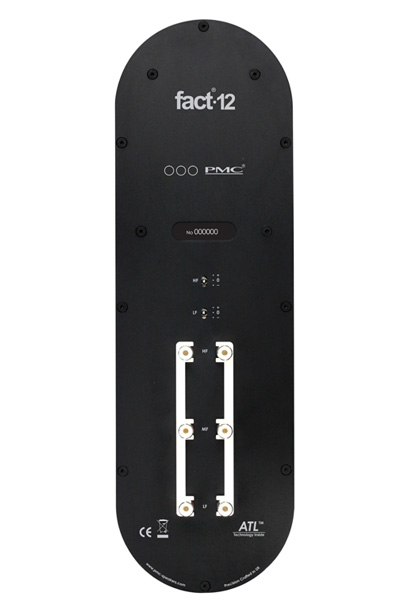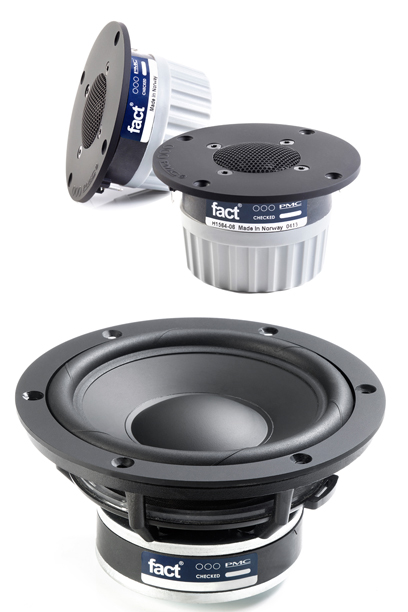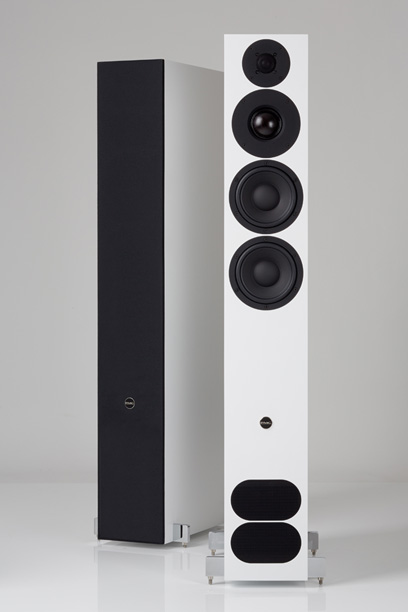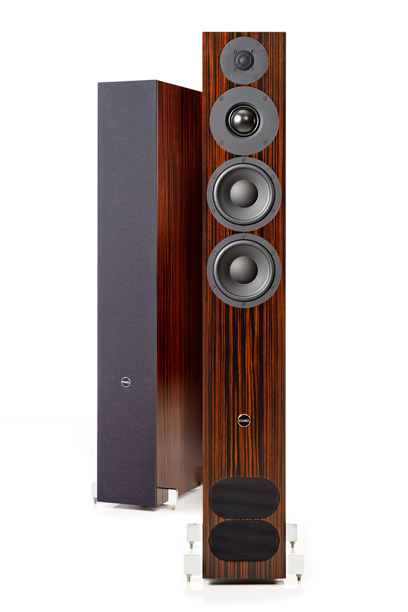Munich 2013 was the place to be for the launch of the latest PMC loudspeaker, the fact.12. The High End Show is filled with all kinds of loudspeakers from the almost affordable up to the very best and most expensive (not necessarily one and the same), it was the perfect showroom. The first notes I heard in the PMC room were amazing and I pushed the Dutch distributor to get the fact.12 to my doorstep as soon as possible. When he did I had the opportunity to listen to one of the most accurate loudspeakers ever in the comfort of my living room.
Most readers will be familiar with the fact story. In 2009 the fact.8 was introduced alongside the smaller fact.3. The fact series differs from other PMC models by virtue of a very narrow baffle and slightly different voicing. Still they are full blown PMC loudspeakers, which means they are as neutral as possible, use an ‘Advanced’ transmission line for better bass, are built in the UK and are informed by PMC’s work in recording studios. The fact.8 and the fact.3 use the same drivers in a two-way arrangement, both with parallel woofers. The new fact.12 is a three-way system, tweeter, midrange dome and again parallel woofers. But there is more than the eye can see, so let us take a closer look into the technical story.

Young blood
The tweeterlooks and is the same as the older fact speakers with a grille over a Sonomex 19mm dome in a 34mm surround. Its magnetic gap is filled with ferro-fluid for quick heat dissipation. In this case the tweeter comes in around 4kHz via a 24dB/octave crossover. The newly developed woofers work from the bottom up to 400 Hz. For the first time in PMC’s history the cones are no longer made from coated paper, instead they decided to use a coated metal cone, a super-long-throw 140mm type to deliver the deepest bass notes with the help of the Advanced Transmission Line (ATL). This is critically damped to preserve a fast response without resonances or standing waves. The midrange (above) is a totally new development as well, it has a soft 50mm dome which is small in comparison with the 75mm dome used in PMC’s pro monitors but built on the same principles. This handmade unit also uses ferro-fluid and has a mounting plate that helps to better dispersion. The fact.12 is the only PMC model so far to use this drive unit.
Being a three-way, PMC decided to put enough connectors on the back to tri-amp the fact.12. Otherwise jumpers connect the terminals for bi- or single amplifier use. On the back we also find small switches to reduce or amplify the output of the tweeter and woofer. Yes, you can increase the bass with the use of a simple switch, which I believe is quite unique. It means you can adjust the fact.12 to the listening room and get optimal high and low frequency responses. In my room I had to reduce the bass output for best results.
The crossover is hand-built with selected components including French Solen capacitors and PMC’s own custom wound inductors, all soldered to a double layer circuit board. As you can read elsewhere on this site PMC developed certain aspects of the fact.12 in co-operation with the National Physical Laboratory. Their method of visualising the radiating sound from the units and the baffle helped to optimise the dispersion, lower distortion and reduce phase problems within the crossover. For the first time at PMC a lot of the engineering work for the fact.12 was done by someone other than founder Pete Thomas, specifically his son Oliver (below). He did the measurements at NPL and transformed the results into improvements for the actual loudspeaker. Compared to the fact.8, the fact.12 has a thicker 35mm front baffle, 50mm thick base, two vents for the ATL and a longer line. This all results in a 25% volume increase over the fact.8 and leaves us with a loudspeaker measuring 1110mm high without its supporting bars and spikes. You need a powerful amplifier for the fact.12 because of its low 84dB/W efficiency.
I used Audia Flight amplifiers, the Strumento No.1 preamp and the model 50 class A power amplifier, capable of delivering 50/100 Watts into 8/4 Ohm impedances. Sources are a NAD M50 and M52 combination with an Esoteric D-07 D/A converter. My music files are in resolutions from 16/44.1 up to 24/192 in FLAC, ALAC and WAV formats. My other source is a Transrotor record player with SME 5009 arm and Transfiguration Axia cartridge with a balanced connection to a hand built tube phono amp. Of course I used my fact.8 loudspeakers as a point of reference. Most cables come from Crystal Cable, with exception of the balanced Yter cables between my DAC, preamp and power amp. The speakers were placed 2.1m (6’10.5”) from each other measured from the centre of the baffle, 70cm (2’3.5”) from the back wall and over one meter (3’) from the side walls. They are slightly toed in for the best results in my 33 square metre (355 square foot) living room.

The performance
So how does the fact.12 perform with a large selection of music, ranging from purist baroque on original instruments via large orchestral works, jazz, pop and a lot of female singers? Things got off to an excellent start with Nardis played by Patricia Barber on her album Café Blue. This contains a very well recorded drum solo ending in a crescendo, followed by very delicate strokes on cymbals, these strokes sounded amazing and convinced me that the tweeter or the crossover in the fact.12 is, on this point at least, superior to the fact.8 or fact.3. The sound is so intense, metallic, singing and yet so natural and light in tone, I never heard this before on any loudspeaker on any occasion as far as I remember. I picked this piece over and over to show audiophile friends how good the tweeter performance is. But of course there is a lot more to listen to and we mustn’t forget that before the cymbals start there is a complete drum kit, including a kicking bass drum. Dry, fast, controlled and explosive are words that seem most apt to describe that sound. Another highlight was The Four Seasons performed by Dutch violin player Janine Jansen. Her (SA)CD contains the quietest sounds from the violin as well as a full orchestra, the fact.12 proved that even music recorded close to the noise floor can be overwhelming thanks to its natural detail. At high volumes I was again and again amazed at how little distortion came from the fact.12, the only reason I didn’t play at full tilt all night was to keep my neighbours from banging on the door. It is clear where these loudspeakers come from, from bigger and smaller brothers and sisters in recording and mastering rooms in studios all over the world. The fact.12 might be best compared to a PMC IB2i or even an MB2i, but housed in a domestically friendly cabinet with real wood veneers. It is that good I promise you, and just as power hungry too.
 |
 |
The score
Let us take a look at the fact.12’s low end. It goes deep, very deep indeed. Listening to Allan Taylor’s The Beat Hotel or The Train Song from Holly Cole, the bass on these can be a bit overwhelming so I adjusted the filter to reduce output which meant that the bass was tight and controlled. Just like a house needs a good foundation, so does music, and the fact.12 delivers. The midrange is built on this foundation, so when Holly Cole sings Be Careful, It’s My Heart, it almost brings me to tears how easily the fact.12 handles her voice and brings her close to me. I know, all reviewers say she’s in the room, I say the same. I wish I could point this out with figures, if I could the fact.12 would get the highest score so far.
The moment I changed to vinyl and played the same Holly Cole piece it became clear how far apart digital and analogue systems still are. I thought that they were getting close when I used the fact.8 but the fact.12 is so much more capable of revealing small details, dynamics and staging, that these two worlds have been separated again. Now I love my vinyl set-up even more than I did. But don’t think that you can’t achieve the same excellent results with digital music, all you have to do is use a very good source. The fact.12 lets you hear every single detail, recording error, microphone bump and studio noise, it will also let you know how well your system performs. If I ever own a pair of fact.12s I might look for a tighter, more powerful amplifier. Something like Audionet AMP monoblocks from Germany that I reviewed recently. The fact.12 is a very direct loudspeaker, not in your face, since the stereo stage is wide open, yet it points exactly to where the singer is or the musicians are. If they are mixed to the left, you get sound from the left. The fact.8 is less directional and has a wider soundstage in my room. This is fun but the fact.12 gets closer to the truth. I played a lot more music with only good results. Tsuyoshi Yamamoto on the Three Blind Mice label performing Misty is amazing, I own the original LP from 1974 and it has enough dynamics to make a smaller amp clip. The piano exposes the speed of the fact.12, yet it is always in control; clear and punchy. Or take Agnes Obel and listen to Riverside from the CD Philharmonics, it will drive you up the wall with pure happiness. Lousy recordings on the other hand, do sound lousy. There’s no cover up, no romance, the fact.12 comes right to the point. I would go so far as to call it unforgiving. If your tastes extend to contemporary pop of the heavily compressed variety you may not like this aspect. But turn to a good recording of a clarinet, tuba, trombone or trumpet, and you get exactly the sound of the original instrument. And just listen to voices, never could I follow the lyrics more easily.
 |
 |
The return
Far too soon I had to return the new PMC speakers to the distributor, but luckily the fact.8 will take their place. And that is a very good loudspeaker for only half the money, but it almost physically hurt to see the fact.12 go out of the door. In Munich I was overwhelmed by this loudspeaker and decided it will be in my next system. Now that I’ve had it at home I want it even more. It sounds so pure yet musical, so fast yet laidback. It is undistorted, full of detail and comes closer to the sound of the original instrument or voice than anything I have heard for a very long time. It wouldn’t be out of place in a high end recording studio. However the looks do make them good enough to put a pair in your living room. Be sure to use an amplifier that can handle the job. Invest in excellent sources, either digital or analogue to extract every single nuance from the carrier. Because the fact.12 is so capable it will reward you with a natural sound that everyone who is used to real voices and instruments at live concerts will enjoy. The fact.12 is the bridge that fills the gap between a domestically acceptable loudspeaker and a heavyweight professional monitor. The fact.12 is the proof that enhanced measurement and design techniques used by young engineers go hand in hand with the skills of experienced designers. This combination of knowledge gave us the fact.12, a speaker which made playing my favourite music so much more enjoyable. Sometimes being a reviewer is a blessing. And yes, I continue saving money for a pair of my own. I can still hear Holly Cole, the piano, the clarinet, the saxophone and last but not least the amazing cymbal sound on Café Blue.
Footnote: René must have saved pretty fast because he had placed his order for a pair of fact.12s before this review was published! Ed.


